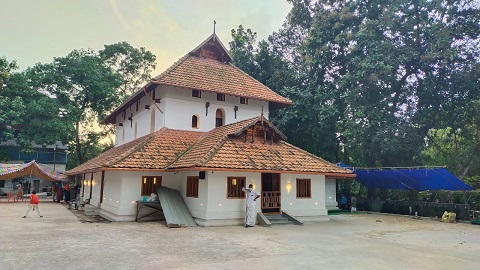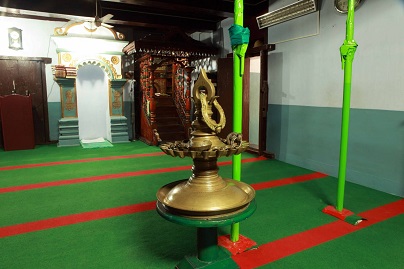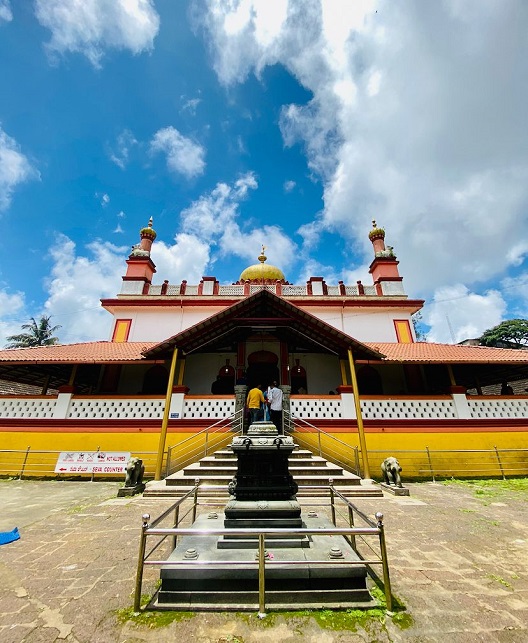An attempt to compare the merits and demerits of two or more religions or cultures, their ideals, practices and beliefs are immature and ridiculous in a civilized society. Each of them possesses their own identity, worth, and natural, expected differences. Each of the worshipping centres belonging to any religion or culture has its traditional style of construction that evolved from time to time. But anyone will be wowed at the rarest presence of the Omkareshwara Temple in Saracenic architecture situated in Madikkeri town, Coorg district of western Karnataka and the Cheraman Perumal Mosque built in typical Kerala temple architecture near Kodungalloor in Thrissur district of Kerala.
A mix of legends and some historical facts reveal that the 19 Perumals ruled a portion of ancient Kerala for 12 years each. The 20th and the most popular Cheraman Perumal reigned the throne for a long 36 years. The legends have it that due to his constant interaction with the Arabian traders, Cheraman Perumal studied and embraced Islam and went to Mecca for Hajj. However, modern historians do not approve of it as a historical fact as they compare the same with that of the advent of St. Thomas and his conversions of the then high-caste Brahmins into Christianity. For a believer, the fact has only a tiny role as far as their belief is concerned.


Cheraman Perumal Mosque is believed to be the very first Mosque built in India. Various perspectives dispute each other on the date of its construction. The undisputed reality is that it was originally built with the same appearance as a traditional Kerala temple with its pyramidical or Chinese pagoda-like roofs, built in wood and paved roof with baked tiles.
“The Mosque was not deliberately built in Kerala’s typical architecture, instead the then popular architecture style was adopted during construction. For instance, many of the buildings in the past are in the same style as it was a popular style of construction, be it a temple or a church or mosque or palace or a house” says Dr Mujeeb, a Lecturer in the Department of General Education, Government of Kerala who did his doctoral thesis in Islamic Architecture, museums and Heritage and is also an expert in temple architecture and Iconography.
Cheraman Perumal Mosque was re-constructed many times in the past and some years ago it was changed into a modern typical Mosque with the Minars and Domes with concrete additions. As the Muziris Heritage Project has also involved Cheraman Perumal Mosque in its list for restoration, the newly-built modern building was demolished and the re-construction works into its original form of the past is going on, but with more space to accommodate more people for prayer. Originally it was a two-story building with a projecting courtyard. The pond in the vicinity is also being re-built. An oil lamp still flames, which is supposed to have been lit during the time of its original construction, is a typical Kerala-styled one. “Our task is to replicate and reinstate the building and its surroundings as was it once in the past” echoes the energic and impeccable passion in the words of Dr Midhun C Shekhar, the Museum Manager of Muziris Projects Ltd. He was seen on the project site with a Dutch architectural expert.


“We are committed to showcasing the cultural togetherness of South India to our Western clients. Hence there will always be an inclusion of Cheraman Mosque in most of the Itineraries that pass through Cochin”, says Prince Charles, General Manager of sales and Marketing of Travel Xs, a Mahabalipuram-based full-fledged Destination Management Company. “A visiting experience of such an extra-ordinary and still active worshipping centre soothe the senses of visitors, which stands as one of the rarest available tangible sediments or you can call as evidence of our age-old and deep-rooted culture that still we are proud to applause”, Charles expresses his pride. As their promotion caption suggests “providing cultural-natural-dailylife-based Experiences are the main motto of Travel Xs rather than just selling popular destinations.
An interesting contrast to the temple-styled Mosque of Kerala is the Omkareshawara Temple in Madikkeri with its dome and tall minarets aimed at the sky. Omkareshawara Temple built in 1820 AD by a local ruler, King Lingarjendra-2, is dedicated to Lord Shiva and replicates a typical Mosque or a Dargah as the construction strictly follows the Saracenic style of architecture.
Unlike all other South Indian temples, the sanctum sanctorum here isn’t surrounded by other deities in small shrines inside the temple complex nor possesses an inner courtyard hall with pillars. A huge dome is built on top of the shrine instead of a Vimana. Vimana or sanctum tower over the main shrine is supposed to be the main character of an Indian temple. Four minarets adorn the four corners of the temple structure which is unavoidable for a typical Mosque in Saracenic architecture.
At the front portion of the temple premises in the middle of the large water tank, Mandapa structures are seen roofed with a medium-sized Saracenic Dome. The structure is well connected with a walkway for the visitors to reach.


Legends abound Omkareshwara Temple says it was built by the King as a solution to the nightmares he had, as a result of his guilt of the cruel killing of a Brahmin who notified the mischiefs of the King. According to the astrologers of the royal court, the King has constructed the temple as repentance for his cruelty.
Ramesh Kumar Magaji, a professional tour guide belonging to India Tourism opines “What attracts a modern visitor in both places is the resemblance of a Temple with that of a Saracenic architecture and vice versa”. Ramesh hailing from Mysore is a keen history enthusiast and handles UK and US markets in his professional arena of tourism.
“In those Itineraries designed along the Malabar Coast, we deliberately include the visits of Cheraman Perumal Mosque near Cochin and Omkareshwareshwara Temple at Coorg if the tour touches a Kerala Package or Karnataka Package respectively, and both these active worshipping centres if the Itinerary is a combination of both these South Indian states”, affirms Vasanthan A – an energetic, young tourism professional-, the Asst. Manager-Operations of Travel Xs, Mahabalipuram. “the awful responses they express during the tours and their thankful notes after the completion of such tours of our clients give us an impression that our decision to include such unforgettable experiences are appreciated”, Vasanthan adds.
Irrespective of the faith both the Cheraman Perumal Mosque and Omkareshwara Temple are visited by folks of all kinds that proclaim a strong sense of religious harmony and an appetite for aesthetic beauty. Aside from being worship centres, these two places are also popular destinations for tourists and architecture enthusiasts.
Written by AJAI KUMAR K S / SRIDEVI NARAYANAN Photography SHAGZIL
Also Read
Watch on Youtube
